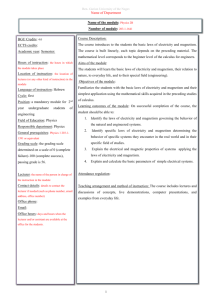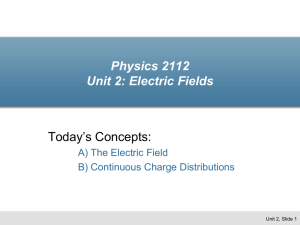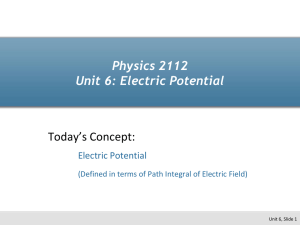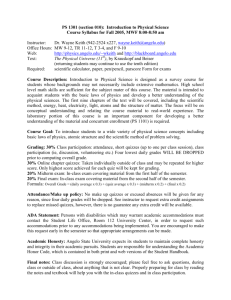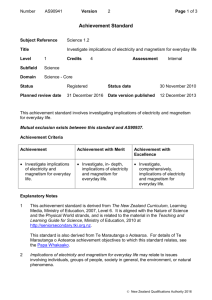Document
advertisement
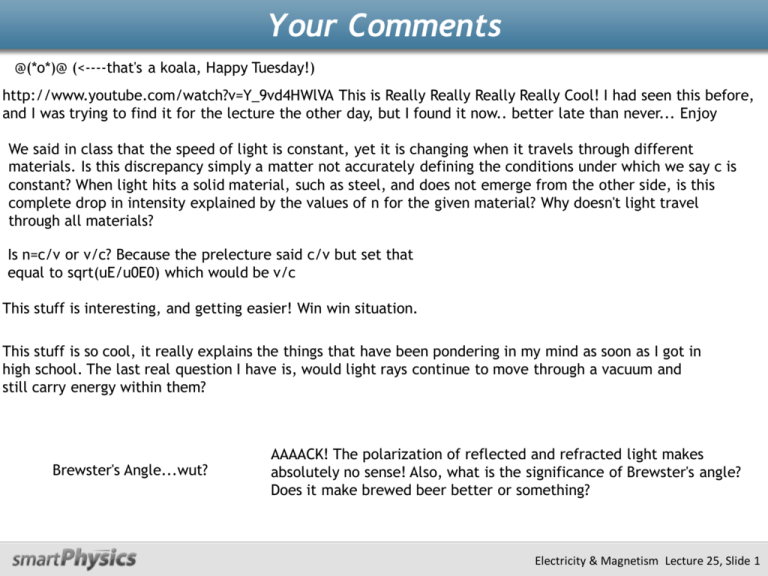
Your Comments @(*o*)@ (<----that's a koala, Happy Tuesday!) http://www.youtube.com/watch?v=Y_9vd4HWlVA This is Really Really Really Really Cool! I had seen this before, and I was trying to find it for the lecture the other day, but I found it now.. better late than never... Enjoy We said in class that the speed of light is constant, yet it is changing when it travels through different materials. Is this discrepancy simply a matter not accurately defining the conditions under which we say c is constant? When light hits a solid material, such as steel, and does not emerge from the other side, is this complete drop in intensity explained by the values of n for the given material? Why doesn't light travel through all materials? Is n=c/v or v/c? Because the prelecture said c/v but set that equal to sqrt(uE/u0E0) which would be v/c This stuff is interesting, and getting easier! Win win situation. This stuff is so cool, it really explains the things that have been pondering in my mind as soon as I got in high school. The last real question I have is, would light rays continue to move through a vacuum and still carry energy within them? Brewster's Angle...wut? AAAACK! The polarization of reflected and refracted light makes absolutely no sense! Also, what is the significance of Brewster's angle? Does it make brewed beer better or something? Electricity & Magnetism Lecture 25, Slide 1 Physics 212 Lecture 25 Electricity & Magnetism Lecture 25, Slide 2 Let’s Start with a Summary: from n2 to n1 Electricity & Magnetism Lecture 25, Slide 3 The speed of light in a medium is slower than in empty space: since e0 > e k is the dielectric constant vmedium = c / nmedium Electricity & Magnetism Lecture 25, Slide 4 CheckPoint 1a “a material changes the speed of light and therefore changes the wavelength” A B C What about the wave must be the same on either side? Observers in both media must agree on the frequency of vibration of the molecules Electricity & Magnetism Lecture 25, Slide 5 Reflection Electricity & Magnetism Lecture 25, Slide 6 Refraction: Snell’s Law D sin 2 D sin 1 c / n2 c / n1 n2 sin 2 n1 sin 1 Electricity & Magnetism Lecture 25, Slide 7 Think of a Day at the Beach What's the fastest path to the ball knowing you can run faster than you can swim? This one is better Not the quickest route… Electricity & Magnetism Lecture 25, Slide 8 A x1 l1 Same Principle works for Light! y1 D y2 l2 x2 Time from A to B : To find minimum time, differentiate t wrt x1 and set 0 How is x2 related to x1? Setting dt/dx1 0 l l t 1 2 v1 v2 B x12 y12 x22 y22 v1 v2 dt x1 x2 dx2 dx1 v1 x12 y12 v2 x22 y22 dx1 x2 D x1 x1 x 2 0 v1l1 v2l2 dx2 1 dx1 sin 1 sin 2 v1 v2 v c/n n1 sin 1 n2 sin 2 Electricity & Magnetism Lecture 25, Slide 9 CheckPoint 2a A B C Snell’s Law: n1 sin1 n2sin2 n decreases increases Electricity & Magnetism Lecture 25, Slide 10 Total Internal Reflection NOTE: n1 > n2 implies 2 > 1 1 > c BUT: 2 has max value = 90o! Total Internal Reflection Electricity & Magnetism Lecture 25, Slide 11 CheckPoint 2b A B C c clearly depends on both n2 and n1 Electricity & Magnetism Lecture 25, Slide 12 Intensity Anything looks like a mirror if light is just glancing off it. If two materials have the same n then its hard to tell them apart. Electricity & Magnetism Lecture 25, Slide 13 Polarization 1 2 90 sin 2 sin(90 1 ) cos 1 Snell’s Law: n2 sin 2 n2 cos 1 n1 sin 1 tan1 n2 n1 Electricity & Magnetism Lecture 25, Slide 14 CheckPoint 1b A B C o = horizontal Electricity & Magnetism Lecture 25, Slide 15 A ball sits in the bottom of an otherwise empty tub at the front of the room. Suppose N people sit high enough to see the ball. Electricity & Magnetism Lecture 25, Slide 16 A ball sits in the bottom of an otherwise empty tub at the front of the room. Suppose N people sit high enough to see the ball. Suppose I fill the tub with water but the ball doesn’t move. Will more or less people see the ball? A) More people will see the ball B) Same # will see the ball C) Less people will see the ball ? A w Snell’s Law: ray bent away from normal going from water to air Electricity & Magnetism Lecture 25, Slide 17 CheckPoint 3 A. Yes B. No The light would go out in all directions, so only some of it would be internally reflected. The person would see the light that escaped after being refracted. Draw some rays Electricity & Magnetism Lecture 25, Slide 18 Example: Refraction at Water/Air Interface Diver’s illusion 97º Diver sees all of horizon refracted into a 97° cone 1 90 n1 n1 1 sin 2 sin 90 n2 n2 1.33 2 48.5 Electricity & Magnetism Lecture 25, Slide 19 Exercise A meter stick lies at the bottom of a rectangular water tank of height 50cm. You look into the tank at an angle of 45o relative to vertical along a line that skims the top edge of the tank. 45o nwater 1.33 50 cm What is the smallest number on the ruler that you can see? 0 20 40 60 80 100 Conceptual Analysis: - Light is refracted at the surface of the water Strategy: - Determine the angle of refraction in the water and extrapolate this to the bottom of the tank. Electricity & Magnetism Lecture 25, Slide 20 Exercise A meter stick lies at the bottom of a rectangular water tank of height 50cm. You look into the tank at an angle of 45o relative to vertical along a line that skims the top edge of the tank. 45o nwater 1.33 50 cm What is the smallest number on the ruler that you can see? 0 20 40 60 80 100 If you shine a laser into the tank at an angle of 45o, what is the refracted angle R in the water ? A) R 28.3o Snell’s Law: B) R 32.1o C) R 38.7o nair sin(45) nwater sin(R) sin(R) nair sin(45)/nwater 0.532 R sin1(0.532) 32.1o Electricity & Magnetism Lecture 25, Slide 21 Exercise A meter stick lies at the bottom of a rectangular water tank of height 50cm. You look into the tank at an angle of 45o relative to vertical along a line that skims the top edge of the tank. 45o nwater 1.33 R 50 cm What is the smallest number on the ruler that you can see? 0 20 40 60 80 100 R 32.1o d What number on the ruler does the laser beam hit? A) 31.4 cm B) 37.6 cm C) 44.1 cm tan(R) d/50 d tan(32.1) x 50cm 31.4cm Electricity & Magnetism Lecture 25, Slide 22 Follow-Up A meter stick lies at the bottom of a rectangular water tank of height 50cm. You look into the tank at an angle of 45o relative to vertical along a line that skims the top edge of the tank. 45o 50 cm nwater 1.33 0 20 40 60 80 100 If the tank were half full of water, what number would the laser hit? (When full, it hit at 31.4 cm) A) 25 cm B) 31.4 cm C) 32.0 cm D) 40.7 cm E) 44.2 cm Electricity & Magnetism Lecture 25, Slide 23 45o 45o nwater 1.33 R 50 cm 50 cm d = 50 cm d 31.4 cm 0 20 40 60 45o 80 0 20 40 60 80 100 100 R 32.1o 50 cm nwater 1.33 R 0 20 d 40.7 cm 40 60 80 100 25 cm (31.4/2) cm Electricity & Magnetism Lecture 25, Slide 24 More Practice A monochromatic ray enters a slab with n1 1.5 at an angle b as shown. b n1 TOP n1 1.5 BOTTOM b n1 A) Total internal reflection at the top occurs for all angles b, such that sinb < 2/3 B) Total internal reflection at the top occurs for all angles b, such that sinb > 2/3 C) There is no angle b (0 < b < 90o) such that total internal reflection occurs at top. Snell’s law: n1 sin 1 n2 sin 2 n sin is “conserved” Ray exits to air with same angle as it entered! Electricity & Magnetism Lecture 25, Slide 25 Follow-Up A ray of light moves through a medium with index of refraction n1 and is incident upon a second material (n2) at angle 1 as shown. This ray is then totally reflected at the interface with a third material (n3). Which statement must be true? 1 n1 n2 A) n3 < n1 B) n1 < n3 n2 C) n3 n2 n3 1 If n1 n3 n1 n2 n3 Want larger angle of refraction in n3 1 n3 < n1 Electricity & Magnetism Lecture 25, Slide 26
